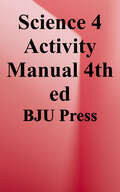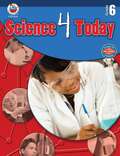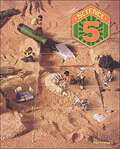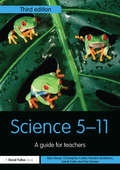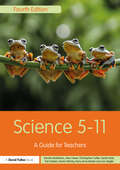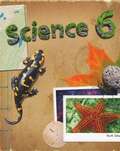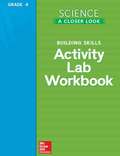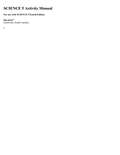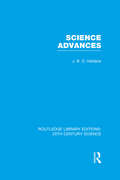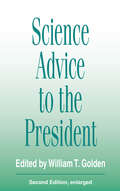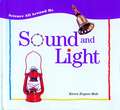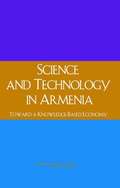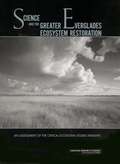- Table View
- List View
Science 4 2nd Edition
by Peggy S. Alier Janet E. Snow Joyce GarlandScience 4 Student textbook for 4th grade.
Science 4 Activity Manual
by Bju PressScience 4 Activity Manual, 4th ed., provides a variety of pages to aid the students' understanding. Pages for recording information for Activity and Exploration lessons reinforce scientific methods. Each chapter includes Study Guides to provide systematic review of concepts for mastery and test preparation as well as Thinking It Through application questions. The Preview page for each chapter can be used to assess students' prior knowledge. Study Skill, Reinforcement, and Expansion pages are also included.
Science 4 Student Guide Part 2
by K12Student Worksheets and Assessments for Units 6 - 10 covering the following topics:<P> Classification of Invertebrates<P> Electricity and Magnetism<P> Rocks and Minerals<P> Weathering, Erosion, and Deposition<P> Fossils and Geologic Time
Science 4 Today: Grade 6
by Margaret FettyScience 4 Today Grade 6 provides five-minute activities for four days a week, covering a 40-week period. A separate, ten-minute assessment is provided on the fifth day of each week, covering the skills and topics of that week. Concepts covered are based on NSTA standards.
Science 4th Grade (California Edition)
by Dinah Zike Jay K. Hackett Richard H. Moyer Joanne Vasquez Mulugheta Teferi Kathryn Leroy Dorothy J. T. Terman Gerald F. WheelerThe text contains lessons on: Life Science: Living things need Energy, Living things and their Environment. Earth Science: Rocks and Minerals, Slow changes on Earth, Fast changes on Earth and Physical Science: Electricity, Magnetism.
Science 5 (4th Edition)
by Peggy S. Alier Janet E. Snow Joyce GarlandA science book that explores God's Word
Science 5 (Third Edition)
by Bob Jones University StaffScience 5 focuses on man's use of God's Creation and design as well as a study of minerals and rocks, fossils, matter and heat, sound and light, weather, biomes, ecosystems, and the respiratory and circulatory systems. The Science 5 student text provides age-appropriate scientific information through text, diagrams, graphs and charts, annotated photographs, and illustrations.
Science 5-11: A Guide for Teachers (Primary 5-11 Series)
by Christopher Collier Dan Davies Alan Howe Sarah Earle Kendra McMahonThis third edition of the bestselling textbook Science 5–11 has been fully updated to provide a synthesis of research and best practice in teaching and learning that focuses on successful ways to engage and motivate young scientists. Responding to the new curriculum, particularly ‘Working Scientifically’, this edition now includes: New sections on whole-school assessment, mentoring, transitions and a topics-based approach. Reference to the ‘big ideas’ of biology, chemistry and physics with chapters clearly related to this new subject structure. Updated tables of progression in each topic area and reference to cross-curricular contexts. New self-assessment questions for teachers, the option for higher-level thinking and further reading. An updated chapter on subject leadership with an increasing emphasis on monitoring progress. Bringing together research undertaken from a range of activities in the field, this book forms a comprehensive and clear guide, outlining the subject knowledge that a teacher needs, the curriculum requirements and the best ways to go about teaching. A practical guide ideal for students, trainees, mentors and other practising teachers, the book provides information on appropriate science topics for Key Stage 1 and 2.
Science 5-11: A Guide for Teachers (Primary 5-11 Series)
by Dan Davies Alan Howe Chris Collier Sarah Earle Kendra McMahon Darren McKay Kerry-Anne Barber Lisa HowarthThis fully updated fourth edition of the bestselling textbook Science 5-11 provides a comprehensive introduction to current research and professional practice for teaching science in the primary school.Chapters are organised into five sections, first introducing theory and practice, then providing specific guidance on teaching topics in biology, chemistry and physics, and finally discussing supporting science across the whole school. Updates to the new edition include: Responding to recent changes in the Initial Teacher Education framework, discussion about cognitive science is integrated more fully throughout. Supporting all children's engagement in science by suggesting inclusive and creative ways of building and consolidating knowledge including making connections between topics and with the wider world. New discussion on planning to support pupil progression in scientific knowledge throughout their time at primary school, building on Early Years and preparing for transition to secondary school. Presenting current research and outlining guidance on best practice, Science 5-11 provides a guide to the subject knowledge, curriculum requirements and pedagogical techniques to successfully teach science within the primary school.
Science 5: Student Activity Manual
by Joyce Garland Christine W. KuhrFor use with SCIENCE 5 Third Edition
Science 6
by Bju PressScience 6 explores earth science, physical science, life science, and the human body. Hands-on activities bring concepts to life, and allow the student to see what biblical principles are at work in nature. <p><p> Clearly-written chapters will help students engage with the subjects introduced, including earthquakes, volcanoes, weathering, natural resources, cells, classification system, reproduction, genetics, atoms, molecules, motion, machines, and the nervous & immune systems. Science experiments, projects, diagrams, and charts are also provided, along with review exercises. 408 pages, softcover.
Science 6 (4th Edition)
by Joyce Garland Janet E. Snow. Peggy S. AkuerLearn more about the science of creation in this textbook.
Science 6 for Christian Schools (Third Edition)
by Bju StaffA science textbook for Christian schools written by members of the faculty and staff of Bob Jones University.
Science A Closer Look Building Skills: Activity Lab Workbook, Grade 4
by Jay K. Hackett Richard H. Moyer Joanne VasquezNIMAC-sourced textbook
Science A Closer Look Building Skills: Assessment, Grade 4
by Jay K. Hackett Richard H. Moyer Joanne VasquezNIMAC-sourced textbook
Science Activity Manual St Gr5
by Bju PressScience 5 teaches students to think about science in light of the Creation Mandate. As students learn about minerals, fossils, matter, light, weather, ecosystems, and the human body, they will learn to appreciate the Creator as well as their own role in the world. Students will learn to apply scientific knowledge to Christian living. They will also develop science-process skills by participating in hands-on activities and projects. The Activity Manual includes pages from Answers in Genesis that tackle the clash between Christian belief and secular science. Answer Key is included in the Science 5 Teacher's Edition with CD (4th ed.).
Science Advances (Routledge Library Editions: 20th Century Science)
by J.B.S. HaldaneThis book offers an overview of a huge range of scientific achievements in the 20th century, specifically in the field of applied science. The majority of the essays originally appeared in papers and journals such as the Daily Worker, New Statesman and Nation, Science and Society and Nature. Insofar as one theme runs through them, it is the application of scientific knowledge for the benefit of human society. The author is unashamed to present his perspective on some of the topics discussed in the context of his commitment to Marxism. This collection of essays, first published in 1947, thus offers an intriguing glimpse of mid-20th century attitudes towards science, and specifically to the possibilities of a scientific approach to the full spectrum of human endeavour as they were perceived in the aftermath of the Second World War, at a time when the Soviet Union and its creed still seemed ascendant.
Science Advice to the President: To The President, Congress And Judiciary
by Jack WerberThis is a provocative, behind-the-scenes introduction to the vital and complex role science plays in United States politics. It includes the first formal statement from former President Clinton's former Science Advisor, John H. Gibbons; a fresh retrospective from D. Allan Bromley on science advice in the George H. W. Bush Administration; and a unique viewpoint from John McTague about his brief tenure under President Reagan. Among the twenty-four contributors are former members of the President's Science Advisory Committee, distinguished scholars, and industrialists.
Science All Around Me: Sound and Light
by Karen Bryant-MoleExplains the basic principles of sound and light through looking at everyday experiences and direct observation.
Science And Spirituality
by Michael RuseMichael Ruse provides a new analysis of the often troubled relationship between science and religion. Arguing against both extremes - in one corner, the New Atheists; in the other, the Creationists and their offspring the Intelligent Designers - he asserts that science is undoubtedly the highest and most fruitful source of human inquiry. Yet, by its very nature and its deep reliance on metaphor, science restricts itself and is unable to answer basic, significant, and potent questions about the meaning of the universe and humankind's place within it: Why is there something rather than nothing? What is the ultimate source and foundation of morality? What is the nature of consciousness? What is the meaning of it all? Ruse shows that one can legitimately be a skeptic about all of these questions, and yet why it is open for a Christian, or member of any faith, to offer answers.
Science And Technology In Armenia: Toward A Knowledge-based Economy
by Committee on Science Technology In ArmeniaAn NRC ad hoc committee analyzed the current status and future development potential of Armenia’s science and technology base, including human and infrastructural resources and research and educational capabilities. The committee identified those fields and institutions offering promising opportunities for contributing to economic and social development, and particularly institutions having unique and important capabilities, worthy of support from international financial institutions, private investment sources, and the Armenian and U.S. governments. The scope of the study included both pure and applied research as well as education in science-related fields. The committee’s report addresses the existing capacity of state and private research institutions, higher education capabilities and trends, scientific funding sources, innovative investment models, relevant success stories, factors hindering development of the science sector, potential domestic Armenian customers for scientific results and products, and opportunities for regional scientific collaboration. An Armenian language version of the report is also available.
Science And The Greater Everglades Ecosystem Restoration: An Assessment Of The Critical Ecosystem Studies Initiative
by Panel to Review the Critical Ecosystem Studies InitiativeThe book reviews a U.S. Department of the Interior research program, finding that it provides key information to support the restoration of the Florida Everglades and to better assess the impact of hydrologic change on the ecosystem. However, the program needs more funding, better management and broader distribution of its findings. The book suggests that strategic investments in Everglades research will increase the chances of reaching restoration goals while reducing overall costs.

